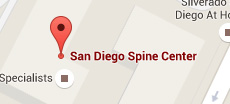Compression Fractures
A compression fracture of the vertebra results in a collapse of the vertebra causing sudden severe back pain. A common cause of compression fractures in the spine is osteoporosis; a condition in which the bone density is reduced. Osteoporosis most commonly affects women over 50 years of age, but it can also affect men. Metastatic spread of cancer to the bones of the spine can also cause vertebral compression fractures.
Symptoms
The primary symptom of vertebral compression fracture is pain, which gets worse on standing or walking and decreases on rest. Patients with compression fractures may also notice a loss of their overall height and a stooped over posture or kyphosis (humpback). Patients may also experience weakness or numbness, and problems with balance. Movements such as twisting or bending may be difficult and painful.
Diagnosis
Vertebral compression fracture can also be associated with several other complications such as additional fractures, spinal deformity, and loss of function. Therefore it is important that compression fractures are diagnosed and treated early. Your doctor will make a diagnosis and determine the cause of pain based on your complete medical history and physical examination. Your doctor will also test your reflexes, muscle strength, and sensory perception. Your doctor may recommend X-rays of the spine to determine the presence of a fracture. An MRI of the spine may be performed to determine the details of the fracture. Sometimes, a CT scan or myelography may be conducted to examine the spinal cord and nerve roots.
Treatment
Treatment of compression fractures comprises of non-surgical and surgical treatment options. The non–surgical treatment options include activity modification, use of pain medications and braces. Surgery includes vertebroplasty and kyphoplasty. These are minimally invasive procedures performed to treat compression fractures.
Kyphoplasty involves insertion of a tube with a deflated balloon at its end, into the fractured vertebra. The balloon is then inflated to restore the height of the collapsed vertebra. Bone cement is injected into the space created by the balloon to maintain the restored height.
Vertebroplasty is very similar to kyphoplasty with the only difference being the absence of a balloon. In vertebroplasty, orthopaedic cement or Polymethyl methacrylate (PMMA) is inserted into the collapsed vertebra through a needle and syringe, under fluoroscopic guidance.
Sometimes an open surgery may be required. Spinal fusion, with the help of bone graft and screws or rods, is used to stabilize the spine.
Depending upon the severity of the fracture and the procedure performed, you may be discharged the same day of your surgery or be hospitalized for a few days.







